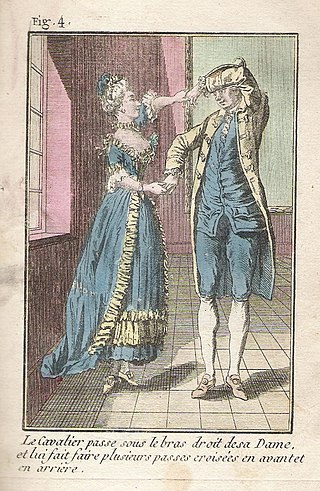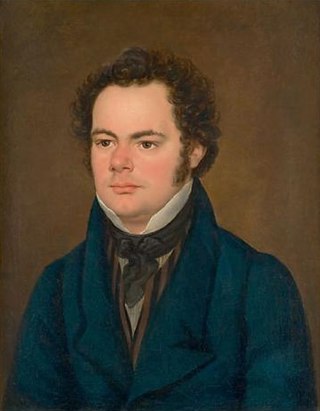Related Research Articles

The pavane is a slow processional dance common in Europe during the 16th century (Renaissance).

An allemande is a Renaissance and Baroque dance, and one of the most common instrumental dance styles in Baroque music, with examples by Couperin, Purcell, Bach and Handel. It is often the first movement of a Baroque suite of dances, paired with a subsequent courante, though it is sometimes preceded by an introduction or prelude. Along with the waltz and ländler, the allemande was sometimes referred to by the generic term German Dance in publications during the late 18th and early 19th centuries.
A prelude is a short piece of music, the form of which may vary from piece to piece. While, during the Baroque era, for example, it may have served as an introduction to succeeding movements of a work that were usually longer and more complex, it may also have been a stand-alone piece of work during the Romantic era. It generally features a small number of rhythmic and melodic motifs that recur through the piece. Stylistically, the prelude is improvisatory in nature. The term may also refer to an overture, particularly to those seen in an opera or an oratorio.

Francesco Canova da Milano was an Italian lutenist and composer. He was born in Monza, near Milan, and worked for the papal court for almost all of his career. Francesco was heralded throughout Europe as the foremost lute composer of his time. More of his music is preserved than of any other lutenist of the period, and his work continued to influence composers for more than a century after his death.

The sarabande is a dance in triple metre, or the music written for such a dance.
Johann Caspar Ferdinand Fischer was a German Baroque composer. Johann Nikolaus Forkel ranked Fischer as one of the best composers for keyboard of his day; however, partly due to the rarity of surviving copies of his music, his music is rarely heard today.

Antonio de Cabezón was a Spanish Renaissance composer and organist. Blind from childhood, he quickly rose to prominence as a performer and was eventually employed by the royal family. He was among the most important composers of his time and the first major Iberian keyboard composer.
Chorale settings refer to a wide variety of musical compositions, almost entirely of Protestant origin, which use a chorale as their basis. A chorale is a simple melody, often based on Gregorian chant, written for congregations to sing hymns. Chorale settings can be vocal, instrumental, or both.

Franz Schubert's Impromptus are a series of eight pieces for solo piano composed in 1827. They were published in two sets of four impromptus each: the first two pieces in the first set were published in the composer's lifetime as Op. 90; the second set was published posthumously as Op. 142 in 1839. The third and fourth pieces in the first set were published in 1857. The two sets are now catalogued as D. 899 and D. 935 respectively. They are considered to be among the most important examples of this popular early 19th-century genre.
Sandrin was a French composer of the Renaissance. He was a prolific composer of chansons in the middle of the 16th century, some of which were extremely popular and widely distributed.

Alessandro Piccinini was an Italian lutenist and composer.

The concerto delle donne was an ensemble of professional female singers of late Renaissance music in Italy. The term usually refers to the first and most influential group in Ferrara, which existed between 1580 and 1597. Renowned for their technical and artistic virtuosity, the Ferrarese group's core members were the sopranos Laura Peverara, Livia d'Arco and Anna Guarini.
"Flow, my tears" is a lute song by the accomplished lutenist and composer John Dowland (1563–1626). Originally composed as an instrumental under the name "Lachrimae pavane" in 1596, it is Dowland's most famous ayre, and became his signature song, literally as well as metaphorically: he would occasionally sign his name "Jo: dolandi de Lachrimae".
Emmanuel Adriaenssen was a Flemish lutenist, composer and master of music. He authored the influential Pratum Musicum, which contains scores for lute solos, and more importantly settings of madrigals for multiple lutes and different ensembles involving lutes and voices. He also had an important influence on the next generation of lutenists through his activity as a teacher of music in his own music school.
The first decade of the 16th century marked the creation of some significant compositions. These were to become some of the most famous compositions of the century.
Francis Cutting (c.1550–1595/6) was an English lutenist and composer of the Renaissance period. He is best known for "Packington's Pound" and a variation of "Greensleeves" called "Divisions on Greensleeves", both pieces originally intended for the lute.
Ennemond Gaultier (c. 1575 – 17 December 1651) was a French lutenist and composer. He was one of the masters of the 17th century French lute school.
Il secondo libro di toccate is a collection of keyboard music by Girolamo Frescobaldi, first published in 1627. A work of immense historical importance, it includes the first known chaconne and passacaglia, as well as the earliest set of variations on an original theme. Il secondo libro di toccate is widely regarded as a high point in Frescobaldi's oeuvre.

Joseph Haydn wrote 123 trios for the unusual combination of baryton, viola and cello. Three further trios for baryton, cello and violin are considered part of the series. As Sisman notes, they are the “most intensively cultivated genre” of Haydn’s early career.
Matthäus Waissel was a German lutenist, editor of music, and writer. Waissel was from 1573 headmaster of a school at Schippenbeil near Königsberg; he published in that year a volume of lute arrangements of vocal pieces, and in 1592 he issued a collection of German dances for lute, which signaled the decline of German lute tablature as it yielded prominence to the so-called French system. Waissel's output comprises three books of solo lute music in all, and one collection of duets. It is unlikely though that any of the pieces in these collections are his own compositions. Waissel's chief importance arguably lies in his expansion of the passamezzo/saltarello pairing into full suites that in form, if not title, comprise some of the earliest true dance suites.
References
- Joan Wess; Victor Anand Coelho (2001). "Joan Ambrosio Dalza". Grove Music Online (8th ed.). Oxford University Press. ISBN 978-1-56159-263-0 . Retrieved 27 December 2006.
- Elaine Sisman (2001). "Variations". Grove Music Online (8th ed.). Oxford University Press. ISBN 978-1-56159-263-0 . Retrieved 17 March 2006.
- Alan Brown (2001). "Pavan". Grove Music Online (8th ed.). Oxford University Press. ISBN 978-1-56159-263-0 . Retrieved 20 December 2006.
- Dinko Fabris (2001). "Tastar de corde". Grove Music Online (8th ed.). Oxford University Press. ISBN 978-1-56159-263-0 . Retrieved 11 December 2006.
- Imogene Horsley. The 16th-Century Variation: A New Historical Survey, Journal of the American Musicological Society, Vol. 12, No. 2/3 (Summer – Autumn, 1959), pp. 118–132.